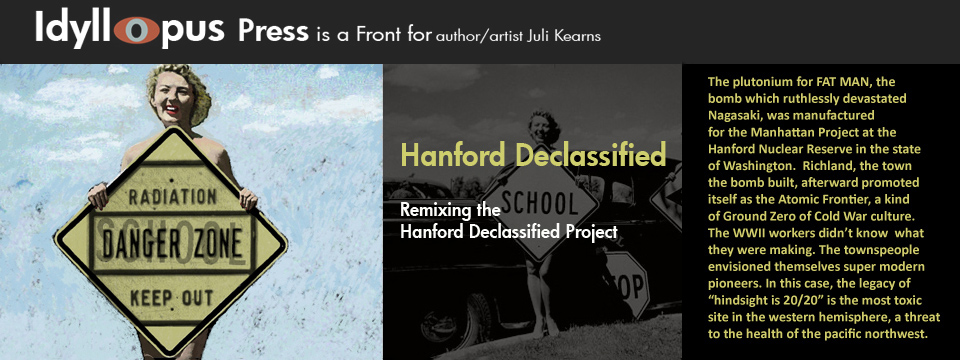Babes in Plutonium Land - The Esquire Girls Perform at Hanford, Declassified
2005
14 w by 10 in h
Digital Painting
Based on a photo from the "Hanford Historical Photo Declassification Project"
© copyright Jk
Read the introduction to the Remixing the Hanford Declassified Project paintings
When you're the third largest boom-war-time population center in Washington state, isolated in the desert, you'd better supply the workers some Xmas fun
It's fun painting transparent veils. The topless woman is standing on hers which led me to wonder how common it was for her to trip on it and how many she ripped a hole in each week.
Despite the transparent veils and ostrich feathers, this image will probably not do very much to help make Hanford a fun and sexy subject, but we can try.
When I realized, several week ago, that there were no references to Nagasaki in the Hanford Historical Photo Declassification Project, for some reason I then wondered if breasts existed in the archive. Because when I realized that there were no references to Nagasaki, and I thought about all that film, and the bathing suit beauties and beauty queens photographed over the years, well I wondered if there were breasts somewhere in those mountains of film, and I wondered if the government would or would not see them as something to declassify and put up with the rest of the images that provide a govt approved portrait of the time and place and people. If I couldn't find any references to Nagasaki in the archive, were there breasts? Wouldn't everyone's brain present them the same question?
Finally, under a search query of just plain "girls" there popped up the images of The Esquire Girls. We know they were not the kind of girls your mom wanted you to grow up to be because Cypress Gardens, during the 40's, was a popular spot for crowning beauty queens, and we find on the web this quote on those beauty queens crowned at Cypress Gardens and how they were good girls, not like the Esquire Girls.
These are not Esquire Girls, but wholesome, young ladies from the area and across the country," explained Dick Pope, the founder, who used the utmost respect when shooting or mailing out photographs of these lovely ladies.
Who says this isn't wholesome?

DDRS Record Details for Record Accession Number
"N1D0005150"
Accession Number N1D0005150
Document Number D-7813-NEG
Alternate Document Number D-7813-NEG
Title Description ESQUIRE GIRL - CAMP HANFORD
Document Date 15-Dec-1944
Public Availability Date 14-Feb-2002
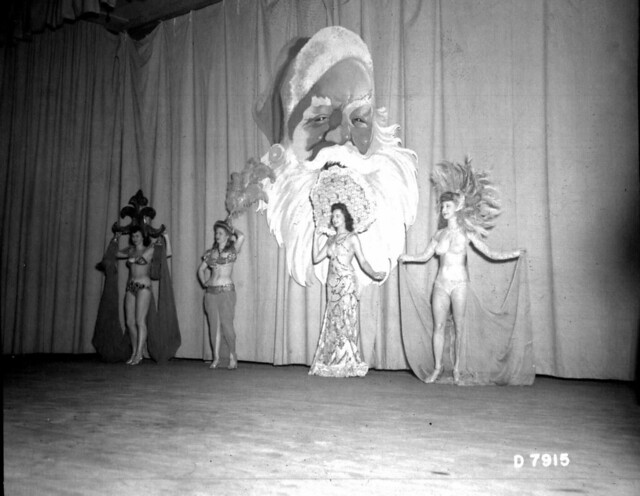
DDRS Record Details for Record Accession Number
"N1D0005214"
Accession Number N1D0005214
Document Number D-7915-NEG
Alternate Document Number D-7915-NEG
Title Description ESQUIRE GIRLS (SHOW GIRLS)
Document Date 04-Dec-2001
Public Availability Date 14-Feb-2002
Men, women and children enjoyed the show. Indeed, they enjoyed the show twice. This photo is from another performance of the Esquire Girls.
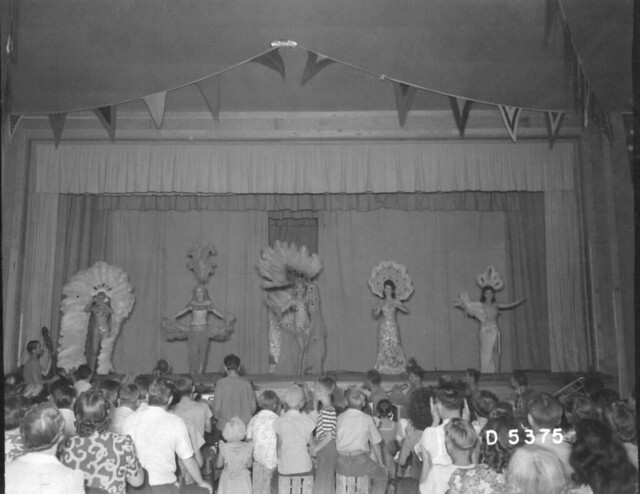
DDRS Record Details for Record Accession Number
"N1D0024866"
Accession Number N1D0024866
Document Number D-5375-NEG
Alternate Document Number D-5375-NEG
Title Description DANCERS
Document Date 04-Dec-2001
Public Availability Date 14-Feb-2002
We know it was Christmas time when the Esquire Girls performed at Hanford. A sign found at the archive reveals it was December 14th at 8:30 p.m.. "Free Vaudeville! The Hollywood Esquire Girls. Singing and Novelty Acts" sponsored by the H.E.W. Employees Association, at the Hanford Auditorium.

DDRS Record Details for Record Accession Number
"N1D0005226"
Accession Number N1D0005226
Document Number D-7927-NEG
Alternate Document Number D-7927-NEG
Title Description SIGN - ESQUIRE GIRLS
Document Date 04-Dec-2001
Public Availability Date 14-Feb-2002
That night, other kinds of daredevils performed
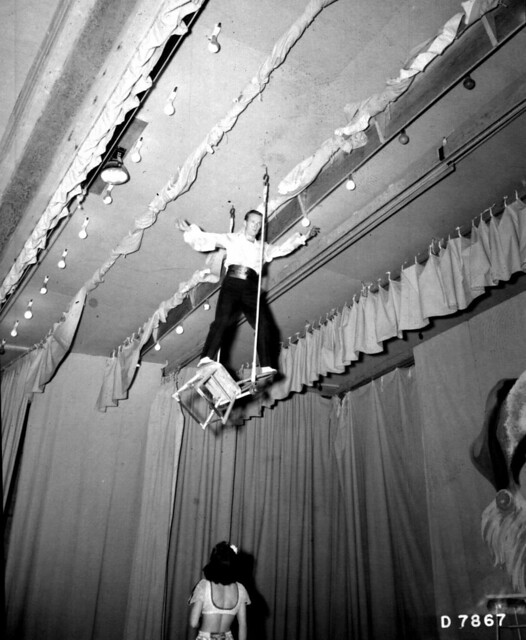
DDRS Record Details for Record Accession Number
"N1D0005155"
Accession Number N1D0005155
Document Number D-7818-NEG
Alternate Document Number D-7818-NEG
Title Description TRAPEZE ARTISTS
Document Date 04-Dec-2001
Public Availability Date 14-Feb-2002
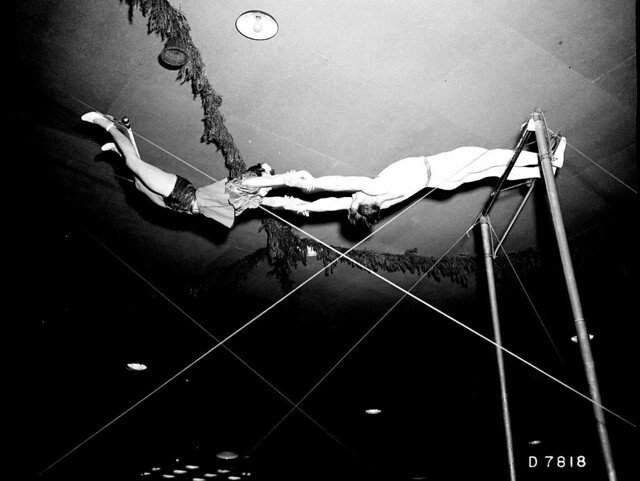
DDRS Record Details for Record Accession Number
"N1D0005174"
Accession Number N1D0005174
Document Number D-7867-NEG
Alternate Document Number D-7867-NEG
Title Description TRAPEZE ARTIST
Document Date 04-Dec-2001
Public Availability Date 14-Feb-2002
It was probably the same year that Kay Kyser, the Professor of Swing. appeared at the auditorium on December 15th, as pics of Kay Kyser have the same Santa floating over his head. A sign for Kay Kyser shows he was performing with Georgia Carroll, Sully Mason and Ish Kabibble and the Geiger Field Band at 7:30 p.m. At 9:30 p.m. was the "Ted Weems Dance". The Kyser show was Friday night only and free. The Weems band was performing Friday and Saturday and the cost was 50 cents for women and a dollar for the men.
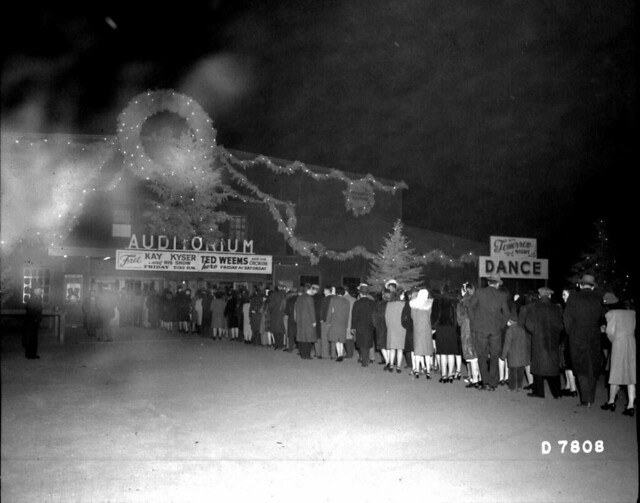
en.wikipedia.org/wiki/Kay_Kyser
DDRS Record Details for Record Accession Number
"N1D0005145"
Accession Number N1D0005145
Document Number D-7808-NEG
Alternate Document Number D-7808-NEG
Title Description KAY KYSER SHOW - CAMP HANFORD
Document Date 18-Dec-1944
Public Availability Date 14-Feb-2002
Don't tell 'em we know 'ya
A document in the archive, dated 15 December 1944, reads:
TO: The Distract Engineer, Manhattan District, Oak Ridge, Tenn. Attn: Lt. Col. W. B. Parsons
Bus collision with S Team locomotive drawing two cars, two cabooses 1750 December 15 at railroad crossing near Hanford due to faulty flagmanship resulted in slight injury to ten bus passengers and more serious injury requiring hospitalizaion to two others... Kay Kyser contacted by this office immediately upon arrival at HEW and advised as to security regulations requiring no mention be made of HEW in future. Yakima Daily Republic 15 December reports Lloyd Wiehl, attorney representing a number of Hanford land owners who settled their claims for less than market value, to be planning to obtain congressional action in the form of additional payments to his clients. Clipping being forwarded. Don Biggs, real estate project manager, Prosser, advises that meeting concerning Hanford land condemnations is planned 27 December, Washington, D.C., to be attended by Frank B. Reid, Lands Division attorney of Department of Justice, S. F. Ramon of Washington, D.C., as well as Biggs, but disclaims knowledge of Wiehl and alleged proposed action.
Matthias
Declassified by CG-SS-4 Sept 2000 and approved for public release.
I wonder why the HEW was given in the Hollywood Esquire Girls poster as sponsoring, but not in the Kyser posters and Kyser was instructed not to ever mention HEW.
As I painted this I kept thinking that these women, after Nagasaki, when the news was revealed the plutonium that killed tens of thousands at Nagasaki was made at Hanford, would have recollected performing there and said, "Wow! I was there! I performed at Hanford!" That is, if news articles on Hanford were published in their towns, and if they saw them. And if they had seen them, perhaps they later told their children, "I performed at Hanford."
I was a Babe in Plutonium Land
Those waging today's battle to save Christmas and its symbols in the supposed war against it, can look to this photo, I suppose, for a reminder of part of what Christmas used to mean back in the Good Ol' Days.
Babes in Plutonium Land.
I find the image endearing because the woman in the harem costume looks like she has stopped caring about presenting a picture of poise, as she attempts to keep her hat from falling off. The woman on the far left is also struggling to keep on her peculiar hat which is perhaps supposed to recall the Queen of Clubs, though her outfit reminds more of Hollywood's idea of a gladiator. In order to keep her hat on, she must hold it with both hands. Again, poor engineering probably demands that the woman second from left keep a hand on her large dinner plate "tea and magnolias in the Southern garden" hat, her outfit designed to please those who found plain, old bare breasts lacking in culture.
Tens of thousands to build the bomb and only a handful funded to clean up the mess
Recent budget cuts on the Hanford clean-up have diminished the roll of employees on the waste treatment plant project to 2,240 workers: 540 craft construction workers and 1,700 nonmanual workers. $3 billion dollars has been spent thus far, and the projected cost of the plant is about $5.7 billion dollars.
Budget cuts mean delays, like the $100 million Bush is preparing to divert to Katrina.
Let's put some perspective on this.
At least 45,000 construction workers were employed at Hanford during the war, and the nearby town of Richland housed some 16,000 employees.
...the US Congress appropriated amounts $250 million in the first year and $500 million in subsequent years to build the Bomb. In addition, the US Army, which managed the project and provided security, infrastructure etc. spent additional $250 million from its budget. Hence the first three US bombs - the laboratory model tested in New Mexico, the Little Boy dropped over (Hiroshima - Gun Barrel, U-235 type) and Fat Man (Plutonium implosion device) dropped over Nagasaki had cost about $2 Billion.
In today's terms (2004), after adjusting for inflation the cost of building first three Bombs of America will be about $15 Billion.
Source: BHARAT RAKSHAK MONITOR - Volume 6(5) March April 2004
The United States ultimately spent $350 billion building nuclear weapons, or almost twice as much as it has spent on space exploration in the same period. The additional money spent on machines to deliver the warheads and on other arms of the Cold War -- basically, the U.S. military budget -- was enough to pay the cost of reconstructing every building and road in the country: $13.5 trillion.
The nuclear standoff arguably bought time that led to the Soviet Union's collapse without a World War III. But our grandchildren will still be paying for cleaning up the resulting nuclear-waste mess.
Source: Seattle Times, "50 Years from Trinity"
So, we could employ tens of thousands of workers at Hanford alone to help in the Manhattan Project's building of three $15 billion bombs.
But we're having difficulty coughing up the several billion needed to clean up the environmental disaster wrought at Hanford which is endangering the Columbia River.
And 2240 people are employed by Bechtel National to work on the project.
Somehow I don't imagine they're going to have free entertainment wishing them happy holidays.
Bechtel laying off 135 employees
This story was published Thursday, November 17th, 2005
By Annette Cary, Herald staff writer
Bechtel National planned to give layoff notices to about 135 workers Wednesday and today because of budget cuts.
That's in addition to 30 workers being transferred to other Bechtel projects at Hanford or elsewhere and 65 union construction workers let go last week.
The loss of those 230 jobs, which include some Washington Group employees, will bring Bechtel costs in line with the $626 million budget for fiscal year 2006 proposed by the Bush administration earlier in the year. However, the budget that's been approved by a U.S. Senate and House conference committee is $100 million less, meaning more layoffs are likely if the president signs a $526 million budget into law.
"We are assessing the impacts of a $526 million budget and have not made any final decisions," Bechtel workers were told in a memo.
The 135 workers receiving notices this week are all nonmanual workers who support construction of Hanford's vitrification plant, or Waste Treatment Plant, including construction engineers, clerks and procurement specialists, said Bechtel spokeswoman Carrie Meyer. Many work in offices at the construction site in central Hanford.
Their jobs will end Jan. 11, and no severance pay is being offered.
The layoffs will drop employment on the project to about 2,240 workers, which includes 540 craft construction workers and 1,700 nonmanual workers.
If Bechtel must meet a $526 million budget, some of the savings are expected to come from cuts in purchasing and subcontracts. In addition, Bechtel is looking at cost savings, such as consolidating nonmanual workers in fewer buildings.
"We're trying to make the government money go further and continue progress on the plant," Meyer said.
The memo to employees pointed out that "while our budget may be considerably less than we had planned for, by all measures the Waste Treatment Plant is still a huge project that remains a critical priority for the Department of Energy."
This month's job cuts come after about 1,000 employees were laid off at the project earlier in the year to reduce spending in fiscal year 2005 and prepare for reduced work in fiscal year 2006, which began in October.
Work slowed this year at key parts of the plant because of technical issues, including a study that showed buildings that would treat or pretreat high-level radioactive waste might not withstand a severe earthquake. The $5.8 billion plant, believed to be the largest construction project in the United States, is planned to treat radioactive waste left from the past production of plutonium for the nation's nuclear weapons program.
The plant would turn waste now held in underground tanks into glass logs for permanent disposal.
Construction on the plant is about 35 percent complete and about $3 billion has been spent. Although the most recent DOE cost estimate for the plant is $5.8 billion, the cost of the plant is expected to have increased substantially because of technical issues, the rising cost of steel and other problems.
"The Department of Energy, Richland Operations Office (RL) has aggressively implemented the commitments made by the Federal Government to openness in Government which was stated as a 'Fundamental principle that an informed citizenry is essential to the democratic process and that the more the American people know about their Government, the better they will be governed. Openness in government is essential to accountability . . .' RL is committed to responsible openness. The Hanford Declassification Project (HDP) was initiated by RL to declassify to the maximum possible extent all previously classified Hanford operations information (documents and photographs). There are over 77,000 declassified photographs of early Hanford (1943 - 1960) available... \These World War II and Cold War era photographs depict early Hanford construction and the employees/families who lived and build/operated the site."
Originally published on my blog in December 21 of 2005.
